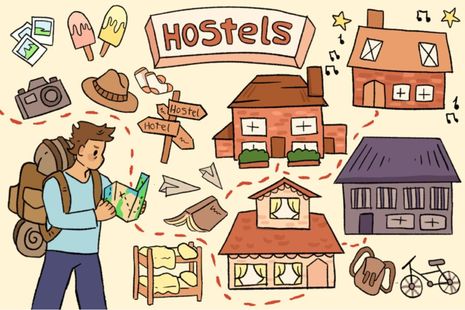The definitive guide to hostels: a ranking by a sleep-deprived interrailer
After a summer of interrailing, Ciaron Tobin provides a comprehensive ranking of the different types of European hostel

Ah, Europe! A continent Americans consider to be a homogenous splodge of vibrant culture, stunning landscapes, delicious food, and, if you’re an interrailer, hostels of varying degrees of dubiousness. After weeks of bouncing between bunks, I’ve become somewhat of a connoisseur of these sanctuaries of sleep (or lack thereof). For those of you considering a last-minute ‘budget’ escapade, here’s my highly scientific, not-at-all biased ranking of hostels across the Channel.
1. The party hostel (aka “sleep is for the weak”)
Location: Every major city
Vibe: Loud, chaotic, and just a little bit sticky.
Key Features: 24/7 bar, free earplugs, questionable stains on every surface.
My first stop was the infamous party hostel in Amsterdam, which I’ll refer to as “El Noche Nunca Muere” (The Night Never Dies). The moment I walked in, I was hit with the smell of stale beer and bad decisions. The lobby looked like the aftermath of a university frat party — cans everywhere, and music that could double as a weapon in warfare.
“The moment I walked in, I was hit with the smell of stale beer and bad decisions”
Here, sleep is a distant dream. Nights blur into mornings, and the concept of “quiet hours” is about as foreign as vegetables on a Spanish tapas menu. But if you’re looking to make friends (or enemies), this is the place. Just be prepared to wake up with at least three strangers’ shoes in your bed.
2. The hippie hostel (aka “peace, love, and unwashed hair”)
Location: Vienna and/or any city with a university.
Vibe: Laid-back, earthy, and a little bit pungent.
Key Features: Macrame hammocks, shared guitars, and an overabundance of incense.
I ventured into the heart of Austria, home to the Schönbrunn Palace and more dreadlocks than you can shake a stick at. I ended up in what I’ll call “Haus der freien Geister” (House of Free Spirits). This hostel was less a building and more an experiment in communal living. Shoes? Optional. Showers? Also, apparently, optional.
“Shoes? Optional. Showers? Also optional, apparently”
The room assignments were more of a suggestion than a rule. I found myself in a mixed dorm, which was fine until I realised that “mixed” referred not just to genders but also to species — there was a frog portrait that seemed to own the place more than the staff did. It’s a haven for those seeking spiritual enlightenment, or at least a solid Wi-Fi connection for their travel blog.
3. The boutique hostel (aka “luxury on a budget … sort of”)
Location: Vienna (again), because of course.
Vibe: Sleek, Instagrammable, and with just a hint of pretentiousness.
Key Features: Designer furniture, artisanal breakfast, and a 70% surcharge for anything that looks cool.
Then there was this boutique IKEA-styled hostel in Vienna, which I’ll dub “Die Herberge der goldenen Träume” (The Hostel of Golden Dreams and/or ‘trauma’). The dorm rooms were surprisingly stylish, with minimalist décor and individual reading lights that probably cost more than my entire rail pass. The clientele? Mostly Instagram influencers and people who use the word “curate” unironically.
“I’m pretty sure I lost a piece of my soul there”
While the atmosphere was undeniably cool, the whole place had an air of forced camaraderie. Events were curated (there’s that word again), and I somehow found myself in a competitive match of artisan coffee shop hunting. Needless to say, I lost, but at least I got a decent cappuccino out of it.
4. The prison hostel (aka “doing time for cheap”)
Location: Some random town you’ve never heard of.
Vibe: Spartan, cold, and slightly unsettling.
Key Features: Metal bunk beds, fluorescent lighting, and the ambience of a Soviet-era detention centre.
Somewhere between the Alps and the Danube, I ended up in a hostel that I’m convinced was a former prison. I’ll call it “El Bastión de la Frugalidad” (The Bastion of Frugality). The building itself was a concrete monstrosity with bars on the windows—not for security, but for decoration, I hoped. The dorm rooms were cavernous and eerily empty, with metal bunks that looked like they’d been sourced from a military surplus store.
The lighting was a harsh fluorescent that flickered ominously, and the bathroom was a place where soap went to die. There was no common area to speak of, just a corridor with a vending machine that looked like it hadn’t been refilled in over 30 years. On the plus side, it was cheap. On the downside, I’m pretty sure I lost a piece of my soul there.
Final thoughts
Interrailing in Europe is an adventure, and the hostels are a huge part of the experience. Whether you’re dancing until dawn, finding your inner zen, or wondering if you’ve accidentally wandered into a minimum-security prison, there’s a hostel out there for everyone. So, use your “research travel grant” from College for your love of German monasteries (in Berlin and Amsterdam) and get going!
 Features / Should I stay or should I go? Cambridge students and alumni reflect on how their memories stay with them15 December 2025
Features / Should I stay or should I go? Cambridge students and alumni reflect on how their memories stay with them15 December 2025 News / Cambridge study finds students learn better with notes than AI13 December 2025
News / Cambridge study finds students learn better with notes than AI13 December 2025 News / Dons warn PM about Vet School closure16 December 2025
News / Dons warn PM about Vet School closure16 December 2025 Comment / The magic of an eight-week term15 December 2025
Comment / The magic of an eight-week term15 December 2025 News / News In Brief: Michaelmas marriages, monogamous mammals, and messaging manipulation15 December 2025
News / News In Brief: Michaelmas marriages, monogamous mammals, and messaging manipulation15 December 2025









